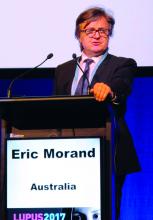MELBOURNE – A metric for low disease activity in lupus is nearly ready for prime-time in both clinical practice and clinical trials, according to speakers at a recent international conference on systemic lupus erythematosus.
The Lupus Low Disease Activity State definition, developed by the Asia Pacific Lupus Collaboration, represents a state which, if sustained, is associated with a low likelihood of adverse outcome, said Mandana Nikpour, MBBS, PhD, of St. Vincent’s Hospital and the University of Melbourne.
Dr. Nikpour told the conference that the diversity of clinical phenotypes in lupus and the presence of many disease activity measures has made the definition of active disease quite challenging.“On the other hand, patients that are overall doing relatively well have less active disease and tend to look a little more homogeneous and potentially are easier to define,” Dr. Nikpour said. “If we’re able to define this group of patients who are doing well, that definition could potentially serve as a therapeutic target.”
The consensus definition of a Lupus Low Disease Activity State (LLDAS), contains five items. The first is that the patient must have a SLEDAI-2K score of less than or equal to 4, with no activity in major organs. Secondly, patients must show no new features of lupus activity, compared with the previous assessment. The third LLDAS item is a Physician Global Assessment score of 1 or less on a scale of 0 to 3. The fourth item is a current prednisolone or equivalent dose of 7.5 mg/day or less, and the fifth is that patients are on well-tolerated standard doses of immunosuppressants and approved biologic agents.
While the definition has been retrospectively validated, Dr. Nikpour presented data from a prospective study that examined the agreement between LLDAS and the clinical judgment of 50 lupus experts on 50 cases.
These data showed overall agreement between experts and LLDAS rating of remission or low, moderate, or high disease activity in 78% of cases.
“Where there were disagreements, when we looked at the cases in more detail, it really boiled down to whether the expert felt that serologic activity [such as] low complement/raised anti-dsDNA was important, and some experts also accepted prednisone doses up to 10 mg per day in what they thought would be a low disease activity state,” Dr. Nikpour said.
In the same session, Chak-Sing Lau, MBChB, MD, chair of rheumatology and clinical immunology at the University of Hong Kong, presented data from another prospective, cross-sectional validation study of the LLDAS measure in 339 lupus patients who were followed for 30 months.
This study showed that 92.6% of patients had ever achieved LLDAS during the study period, and 62.1% of patient days were spent in LLDAS. Researchers also found that patients who spent a higher percentage of time in LLDAS had a significantly lower incidence of flare, even after adjustment for gender and age.
Commenting on the study, Dr. Nikpour said LLDAS could be a feasible target for lupus – or at least part of one – and a therapeutic endpoint or outcome measure in clinical trials.
“We now have a prospective validation of LLDAS in the Asia Pacific cohort, again looking at protection against future flares, damage accrual, and perhaps even mortality, and a state which confers better health-related quality of life,” she said in an interview.
In another presentation, Eric F. Morand, MD, PhD, head of the Monash Health Rheumatology Unit at Monash University, Melbourne, showed data from the phase IIb MUSE trial of the investigational drug anifrolumab, which suggested LLDAS also had utility as a clinical trial endpoint for lupus.The study involved 305 patients with active disease who were randomized to standard of care plus 300 mg or 1,000 mg anifrolumab every 4 weeks, or placebo, with follow-up at 28 and 52 weeks.
The analysis showed that LLDAS was strongly associated with the trial’s primary endpoint of SRI-4 response plus a sustained reduction of oral corticosteroid dose to below 10 mg/day, although LLDAS also proved itself more stringent than the SRI-4 response criteria.
Similarly, LLDAS attainment was strongly associated with BILAG (British Isles Lupus Assessment Group)–Based Composite Lupus Assessment response but again, was more stringent. However LLDAS was less stringent than the major clinical response definition used in the study, which was BILAG ‘C’ or less across all systems for a minimum of 6 months.
Patients who achieved a low disease activity state at week 52 also showed significantly greater improvements in patient global score, and in seven of the eight lupus quality of life domains, compared with patients who did not achieve LLDAS.
“The purpose of this analysis is not to evaluate the efficacy of anifrolumab but rather to evaluate the utility of this measure, and we believe that this has been attained,” Dr. Morand told the audience.
In an interview, Dr. Morand said the accumulating evidence for the validity of LLDAS both in clinical trials and clinical practice was approaching a tipping point, with numerous presentations at the conference addressing the question of LLDAS.
“Of course those findings have to be peer reviewed and published, and probably it needs to be tested in another clinical trial or two and still hold water, but I think it’s got momentum now.”
Dr. Nikpour declared research support, honoraria, and consultancies with several pharmaceutical companies. The MUSE trial was funded by MedImmune, and Dr. Morand declared research support, consultancies and travel funding from several pharmaceutical companies. Dr. Lau declared advisory board and consultancy roles with several pharmaceutical companies.


